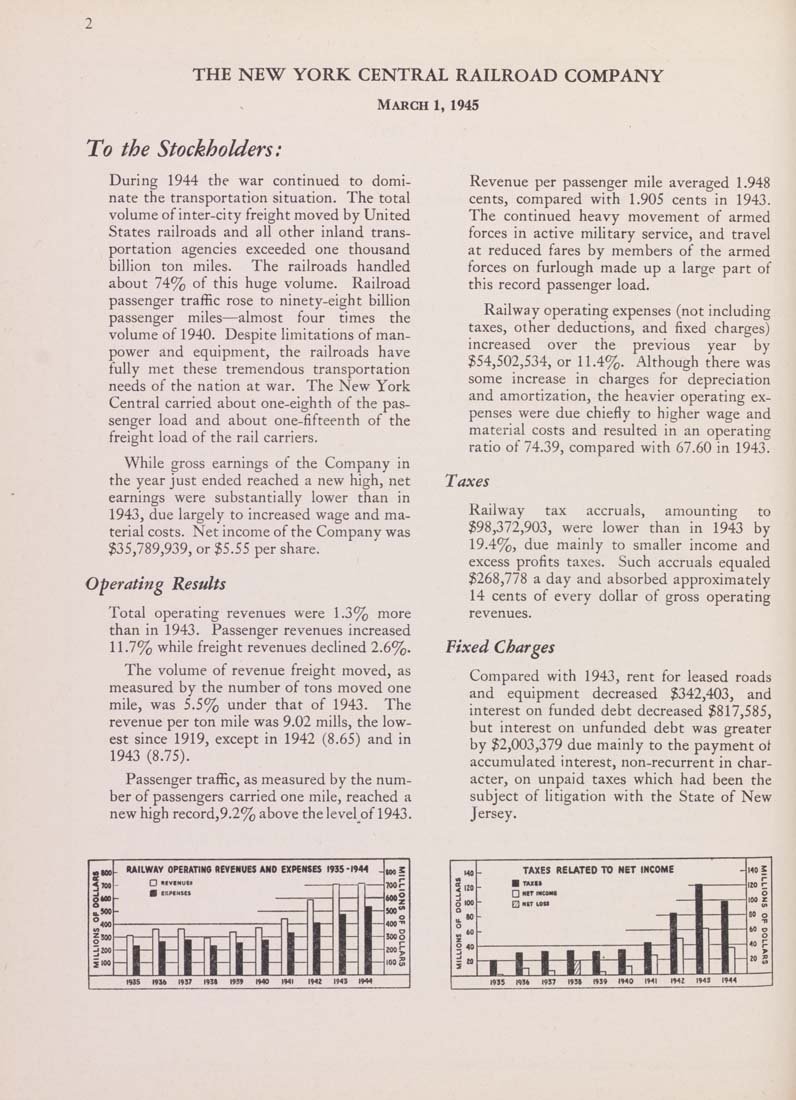THE NEW YORK CENTRAL RAILROAD COMPANY
March 1, 1945
To the Stockholders:
During 1944 the war continued to domi¬
nate the transportation situation. The total
volume of inter-city freight moved by United
States railroads and all other inland trans¬
portation agencies exceeded one thousand
billion ton miles. The railroads handled
about 74% of this huge volume. Railroad
passenger traffic rose to ninety-eight billion
passenger miles—almost four times the
volume of 1940. Despite limitations of man¬
power and equipment, the railroads have
fully met these tremendous transportation
needs of the nation at war. The New York
Central carried about one-eighth of the pas¬
senger load and about one-fifteenth of the
freight load of the rail carriers.
While gross earnings of the Company in
the year just ended reached a new high, net
earnings were substantially lower than in
1943, due largely to increased wage and ma¬
terial costs. Net income of the Company was
$35,789,939, or $S.SS per share.
Operating Results
Total operating revenues were 1.3% more
than in 1943. Passenger revenues increased
11.7% while freight revenues declined 2.6%.
The volume of revenue freight moved, as
measured by the number of tons moved one
mile, was S.S% under that of 1943. The
revenue per ton mile was 9.02 mills, the low¬
est since 1919, except in 1942 (8.65) and in
1943 (8.75).
Passenger traffic, as measured by the num¬
ber of passengers carried one mile, reached a
new high record,9.2% above the level of 1943.
Revenue per passenger mile averaged 1.948
cents, compared with 1.905 cents in 1943.
The continued heavy movement of armed
forces in active military service, and travel
at reduced fares by members of the armed
forces on furlough made up a large part of
this record passenger load.
Railway operating expenses (not including
taxes, other deductions, and fixed charges)
increased over the previous year by
$54,502,534, or 11.4%. Although there was
some increase in charges for depreciation
and amortization, the heavier operating ex¬
penses were due chiefly to higher wage and
material costs and resulted in an operating
ratio of 74.39, compared with 67.60 in 1943.
Taxes
Railway tax accruals, amounting to
$98,372,903, were lower than in 1943 by
19.4%, due mainly to smaller income and
excess profits taxes. Such accruals equaled
$268,778 a day and absorbed approximately
14 cents of every dollar of gross operating
revenues.
Fixed Charges
Compared with 1943, rent for leased roads
and equipment decreased $342,403, and
interest on funded debt decreased $817,585,
but interest on unfunded debt was greater
by $2,003,379 due mainly to the payment ol
accumulated interest, non-recurrent in char¬
acter, on unpaid taxes which had been the
subject of litigation with the State of New
Jersey.
wMO
ae
^700
gtOO
U.500
°400
v>
|J00
3200
§100
RAILWAY OPERATING REVENUES AND EXPENSES 1935-1944
■ EliPtNSES
aMJi
TOOp
«oo|
MO"
o
400 ■"
o
300O
2005
100 S
1935 1936 l»S7 I9M I9» 19*) 1941 1942 I94J 1944
MO
^120
o 100
o
«.»
o
«• *°
z
2 40
.J
^ 20
s
TAXES RELATED TO NET INCOME
■ TAXt*
Q NITIMOIM
-
140 Z
r
O
Q NiT lOM
1
■n
. 1
O
40 P
1 1 1 1 1 ll 1
>
L In I fc i ll 1 1
1935 M36 1937 I95» 1939 1940 1941 1942 1943 1944
|








